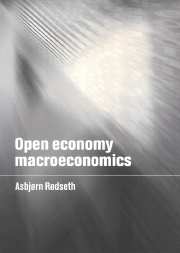Book contents
- Frontmatter
- Contents
- List of figures
- List of tables
- Preface
- List of standard symbols
- Introduction
- Part 1 Financial markets
- 1 The foreign exchange market
- 2 Portfolio choice, risk premia and capital mobility
- 3 Money
- 4 The monetary theory of the exchange rate
- Part 2 The open economy
- Part 3 Policy issues
- Appendixes
- Notes
- Bibliography
- Index
4 - The monetary theory of the exchange rate
Published online by Cambridge University Press: 06 July 2010
- Frontmatter
- Contents
- List of figures
- List of tables
- Preface
- List of standard symbols
- Introduction
- Part 1 Financial markets
- 1 The foreign exchange market
- 2 Portfolio choice, risk premia and capital mobility
- 3 Money
- 4 The monetary theory of the exchange rate
- Part 2 The open economy
- Part 3 Policy issues
- Appendixes
- Notes
- Bibliography
- Index
Summary
The focus in this chapter is on a floating exchange rate. In chapters 1–3 we have seen how important exchange rate expectations are in determining the exchange rate. So far, we have just postulated that expected depreciation is a function of the present exchange rate. The main purpose of the present chapter is to show how this postulated function can be replaced by the assumption of rational expectations. By ‘rational expectations’ we here mean expectations which are consistent with the model we use for determining the exchange rate.
The monetary approach to exchange rate determination is useful for introducing rational expectations because it provides a particularly simple model. It is based on five main assumptions:
Perfect mobility of goods and services, which implies purchasing power parity (PPP). Measured in the same currency goods prices are the same at home and abroad.
Perfect mobility of capital, which implies uncovered interest rate parity.
Wage flexibility, which implies that domestic output is determined from the supply side.
Exogenous money supply.
Model-consistent expectations.
We still focus on a small economy, which means that the foreign price level and the foreign interest rate are exogenous.
The monetary approach to exchange rate determination has a long history (see Frenkel, 1976). Of particular importance were the writings of Gustav Cassel in the period 1919–30.
- Type
- Chapter
- Information
- Open Economy Macroeconomics , pp. 97 - 110Publisher: Cambridge University PressPrint publication year: 2000



